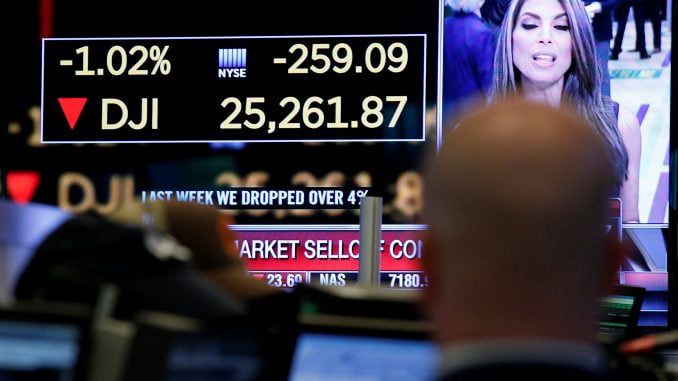
Feb 5 – (Reuters) U.S. stocks sold off sharply on Monday, with the Dow industrials falling back below 25,000, as a pullback from record highs deepened and investors grappled with rising bond yields and potentially firming inflation.
All three major U.S. indexes fell more than 1 percent while the Dow and S&P 500 dropped more than 2 percent. Late in the session, the Dow was down more than 1,000 points.
The energy, financials and healthcare sectors fell the most, but declines were spread broadly as all major 11 S&P groups dropped.
During Monday’s session, the benchmark S&P 500’s fall on Monday put its pullback from its Jan 26 record high at more than 6 percent.
Friday’s jobs report sparked worries over the prospects for inflation and a surge in bond yields, as well as concerns the Federal Reserve will raise rates at a faster pace than expected.
Benchmark 10-year note yields pulled back after surging to 2.885 percent overnight, the highest since January 2014.
“When you have rates moving upwards, typically what happens is that financial conditions tighten, things like bank lending, mortgage lending start to slow and then the economy is at risk of a potential downturn,” said Mona Mahajan, U.S. investment strategist with Allianz Global Investors in New York.
The Dow Jones Industrial Average fell 857.9 points, or 3.36 percent, to 24,663.06, the S&P 500 lost 73.53 points, or 2.66 percent, to 2,688.6 and the Nasdaq Composite dropped 160.71 points, or 2.22 percent, to 7,080.23.
The Dow industrials fell below 25,000 for the first time since January 4.
The S&P 500 and Dow fell below their respective 50-day moving averages, a closely watched support level.
The CBOE Volatility index, the closely followed measure of expected near-term stock market volatility, jumped 13.40 points to 30.71, its highest level since February 2016.
The declines come after the Dow and S&P posted their biggest weekly percentage drops since January 2016, and the Nasdaq posted its biggest weekly drop since February 2016.
“I think what you’re getting is a re-calibration in both the bond and stock markets,” said Richard Bernstein, CEO of Richard Bernstein Advisors in New York.
“Nobody can time short-term corrections. The question is whether you’re heading for a multi-quarter curl-your-toes market in equities and that’s not on our radar.”
A drop in oil prices and bitcoin on Monday also may have weighed on the sentiment for risk assets overall, pulling down equities.
The stock market’s recent slide comes during an relatively solid earnings season that investors have cited for support for equities.
With just over half of S&P 500 companies having reported, earnings are expected to have climbed 13.6 percent for the fourth quarter, according to Thomson Reuters I/B/E/S.
Declining issues outnumbered advancing ones on the NYSE by a 5.92-to-1 ratio; on Nasdaq, a 4.59-to-1 ratio favored decliners.
The S&P 500 posted 1 new 52-week highs and 23 new lows; the Nasdaq Composite recorded 17 new highs and 126 new lows.




